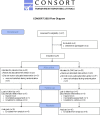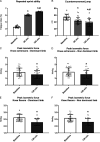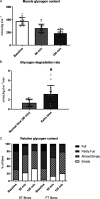Extended Match Time Exacerbates Fatigue and Impacts Physiological Responses in Male Soccer Players
- PMID: 35977104
- PMCID: PMC9770137
- DOI: 10.1249/MSS.0000000000003021
Extended Match Time Exacerbates Fatigue and Impacts Physiological Responses in Male Soccer Players
Abstract
Purpose: This study evaluated how extended match time (90 + 30 min) affected physiological responses and fatigue in male soccer players.
Methods: Twenty competitive players (mean ± SD: age, 20 ± 1 yr; maximal oxygen uptake, 59 ± 4 mL·min -1 ·kg -1 ) completed an experimental match with their activity pattern and heart rate assessed throughout the game, whereas countermovement jump performance and repeated sprint ability were tested and quadriceps muscle biopsies and venous blood samples were taken at baseline and after 90 and 120 min of match play.
Results: Less high-intensity running (12%) was performed in extra time in association with fewer intense accelerations and decelerations per minute compared with normal time. Peak sprint speed was 11% lower in extra time compared with normal time, and fatigue also manifested in impaired postmatch repeated sprint ability and countermovement jump performance (all P < 0.05). Muscle glycogen declined from 373 ± 59 mmol·kg -1 dry weight (dw) at baseline to 266 ± 64 mmol·kg -1 dw after 90 min, with a further decline to 186 ± 56 mmol·kg -1 dw after extra time ( P < 0.05) and with single-fiber analyses revealing depleted or very low glycogen levels in ~75% of both slow and fast twitch fibers. Blood glucose did not change during the first 90-min but declined ( P < 0.05) to 81 ± 8 mg·dL -1 after extra time. Plasma glycerol and ammonia peaked at 236 ± 33 mg·dL -1 and 75 ± 21 μmol·L -1 after the extra period.
Conclusions: These findings demonstrate exacerbated fatigue after extra time compared with normal time, which seems to be associated with muscle glycogen depletion, reductions in blood glucose levels, and hyperammonemia. Together, this points to metabolic disturbances being a major part of the integrated and multifaceted fatigue response during extended soccer match play.
Trial registration: ClinicalTrials.gov NCT04159194.
Copyright © 2022 The Author(s). Published by Wolters Kluwer Health, Inc. on behalf of the American College of Sports Medicine.
Figures





References
-
- Nassis GP Massey A Jacobsen P, et al. . Elite football of 2030 will not be the same as that of 2020: preparing players, coaches, and support staff for the evolution. Scand J Med Sci Sports. 2020;30(6):962–4. - PubMed
-
- Nybo L, Girard O, Mohr M, Knez W, Voss S, Racinais S. Markers of muscle damage and performance recovery after exercise in the heat. Med Sci Sports Exerc. 2013;45(5):860–8. - PubMed
-
- Krustrup P Mohr M Nybo L, et al. . Muscle metabolism and impaired sprint performance in an elite women’s football game. Scand J Med Sci Sports. 2022;32(1 Suppl):27–38. - PubMed
Publication types
MeSH terms
Substances
Associated data
LinkOut - more resources
Full Text Sources
Medical

